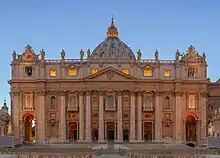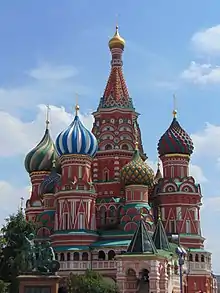Christianity in Europe
Christianity is the largest religion in Europe.[2] Christianity has been practiced in Europe since the first century, and a number of the Pauline Epistles were addressed to Christians living in Greece, as well as other parts of the Roman Empire.

| 95–100% | |
| 90–95% | |
| 80–90% | |
| 70–80% | |
| 60–70% | |
| 50–60% | |
| 30–40% | |
| 20–30% | |
| 10–20% | |
| 5–10% | |
| 2–4% | |
| < 1% |
| Christianity by country |
|---|
 |
|
|
| Part of a series on |
| Christianity |
|---|
 |
According to a 2010 study by the Pew Research Center, 76.2% of the European population identified themselves as Christians.[3]
As of 2010, Roman Catholics were the largest Christian group in Europe, accounting for more than 48% of European Christians.[3] The second-largest Christian group in Europe were the Orthodox, who made up 32% of European Christians.[3] About 19% of European Christians were part of the mainline Protestant tradition.[3] Russia is the largest Christian country in Europe by population, followed by Germany and Italy.[3]
Since at least the legalization of Christianity by the Roman Emperor Constantine in the 4th century, Europe has been an important centre of Christian culture, even though the religion was inherited from the Middle East and important Christian communities have thrived outside Europe such as Oriental Orthodoxy and the Church of the East since the time of Christ. Christian culture has been an important force in Western civilization, influencing the course of philosophy, art, and science.[4][5]
Historically, Europe has been the center and "cradle of Christian civilization".[6][7][8][9] Christianity played a prominent role in the development of the European culture and identity.[10][11][12] Europe has a rich Christian culture, especially as numerous saints and martyrs and almost all the popes were European themselves. All of the Roman Catholic popes from 741 to 2013 were from Europe.[13] Europe brought together many of the Christian holy sites and heritage and religious centers.[14]
History
Early history
Historians believe that St. Paul wrote his first epistle to the Christians of Thessaloniki (Thessalonians) around AD 52.[15] His Epistle to the Galatians was perhaps written even earlier, between AD 48 and 50.[16] Other epistles written by Paul were directed to Christians living in Greece (1 Corinthians, 2 Corinthians, Philemon, Philippians, 2 Thessalonians) and Rome (Romans) between the 50s and 70s of the first century.
The Record of Saint Dorotheus (Bishop of Tyre) is that the Church at Tyre sent Aristobulus (of the seventy) to Britain as bishop in AD 37. The Church seems to have been begun by him around the Bristol Channel area and 150 years later we have names of bishops recorded. By AD 550 there are recorded 120 bishops spread throughout the British Isles. Before they were a recognized religion in Europe, Christians faced punishment and persecution for their first centuries in Europe, especially during the first. They were targeted by Emperor Nero who is rumored to have ordered the colossal fire in Rome, destroying the city in AD 64. The reasons for their persecution vary. Many believe Christians to have been scapegoats, when the real issues were local or political.
Armenia was the first state in the world to adopt Christianity as its state religion in AD 301. The oldest state-built church in the world, Etchmiadzin Cathedral, was built between AD 301–303. It is the seat of the Armenian Apostolic Church. The Roman Empire officially adopted Christianity in AD 380. During the Early Middle Ages, most of Europe underwent Christianization, a process essentially complete with the Baltic Christianization in the 15th century. The emergence of the notion of "Europe" or the "Western World" is intimately connected with the idea of "Christendom", especially since Christianity in the Middle East was marginalized by the rise of Islam from the 7th century, a constellation that led to the Crusades, which although unsuccessful militarily were an important step in the emergence of a religious identity of Europe. At all times, traditions of folk religion existed largely independent from official denominations or dogmatic theology.[4]
From the Middle Ages onwards, as the centralized Roman power waned in southern and central Europe, the dominance of the Catholic Church was the only consistent force in Western Europe.[4]
Movements in art and philosophy, such as the Humanist movement of the Renaissance and the Scholastic movement of the High Middle Ages, were motivated by a drive to connect Catholicism with Greek thought imported by Christian pilgrims.[17][18][19]
East–West Schism and Protestant Reformation
.jpg.webp)
The East–West Schism of the 11th century and the Protestant Reformation of the 16th divided "Christendom" into hostile factions. Following the Age of Enlightenment of the 18th century, atheism and agnosticism became widespread in Western Europe. 19th-century Orientalism contributed to a certain popularity of Buddhism, and the 20th century brought increasing syncretism, New Age and various new religious movements divorcing spirituality from inherited traditions for many Europeans. The latest history brought increased secularisation, as well as religious pluralism.[20]
According to Scholars, in 2017, Europe's population was 77.8% Christian (up from 74.9% 1970),[21][22] these changes were largely result of the collapse of Communism and switching to Christianity in the former Soviet Union and Eastern Bloc countries.[21]
Cultural influences
.jpg.webp)
Western culture, throughout most of its history, has been nearly equivalent to Christian culture, and many of the population of the Western hemisphere could broadly be described as cultural Christians. The notion of "Europe" and the "Western World" has been intimately connected with the concept of "Christianity and Christendom" many even attribute Christianity for being the link that created a unified European identity.[23]
Though Western culture contained several polytheistic religions during its early years under the Greek and Roman empires, as the centralized Roman power waned, the dominance of the Catholic Church was the only consistent force in Europe.[4] Until the Age of Enlightenment,[24] Christian culture guided the course of philosophy, literature, art, music and science.[4][25] Christian disciplines of the respective arts have subsequently developed into Christian philosophy, Christian art, Christian music, Christian literature etc.
Christianity had a significant impact on education and science and medicine as the church created the bases of the Western system of education,[26] and was the sponsor of founding universities in the Western world as the university is generally regarded as an institution that has its origin in the Medieval Christian setting.[27][28] Many clerics made significant contributions to science and Jesuits, in particular, made numerous significant contributions to the development of science.[29][30][31] The Civilizing influence of Christianity (in Europe) includes social welfare,[32] founding hospitals,[33] economics[34][35] politics,[36] architecture,[37] literature[38] and family life.[39]
Although the Protestant Reformation was a religious movement, it also had a strong impact on all other aspects of European life: marriage and family, education, the humanities and sciences, the political and social order, the economy, and the arts.[40]
Denominations
Distribution of Christians in Europe by denomination[41]
- Catholic Church: European countries with significant or majority Catholic populations are Andorra, Austria, Belarus (western), Belgium, Bosnia and Herzegovina (central and southwestern part), Croatia, France, Germany (western and southern regions), Hungary, Republic of Ireland, Italy, Latvia (the Latgale region), Liechtenstein, Lithuania, Luxembourg, Malta, Monaco, Netherlands (eastern and southern regions), Poland, Portugal, San Marino, Slovakia, Slovenia, Spain, Switzerland (central and southern regions), Ukraine (western part) and Vatican City.[42] There is also large Catholic minority in Albania (10–15%).[43] In the Czech Republic and the United Kingdom, Catholics comprise roughly 10% of the population. In Serbia and Romania, Catholics constitute over 5% of the overall population.
- Eastern Catholic Churches are found mostly in Ukraine (western), Italy (southern), Slovakia (eastern), Romania and Hungary. Small numbers of adherents exist in Russia, Serbia, Poland, France (especially Corsica), North Macedonia, and Greece. Most Catholics in Scandinavia are the result of immigration from other countries in Europe (primarily Italy and Poland) and elsewhere.
- Eastern Orthodox Christianity: European countries or areas with significant Eastern Orthodox populations are Belarus, Bulgaria, Bosnia and Herzegovina (northern and eastern parts), Cyprus, Georgia, Greece, North Macedonia, Moldova, Montenegro, Romania, Russia, Serbia, Ukraine, and the European part of Kazakhstan.[42] Eastern Orthodox Christians form large minorities in Albania and Estonia.[lower-alpha 1] Small minorities of Eastern Orthodox Christians live in Finland (especially Karelia), Lithuania, Armenia, and eastern Poland.
- Oriental Orthodox Christianity: Armenia has a large Oriental Orthodox majority.
- Protestantism: European countries or areas with significant Protestant populations are Denmark, Finland, Germany (central, eastern and northern regions), United Kingdom, Iceland, Netherlands (central and northern regions), Northern Ireland, Norway, Sweden, and Switzerland (except the southern part).[42] There are significant Protestant minorities in Estonia, Latvia, France, the northeastern Piedmont region of Italy, Slovakia, the western and southern parts of Germany, eastern Hungary, the Czech Republic, Poland, Serbia, and Romania.
- Anglicanism (or Episcopalianism, in Scotland) is the largest denomination in the United Kingdom (England and Wales), with a large minority in Northern Ireland, and small numbers in the Republic of Ireland, Malta, Scotland,[42] Spain and Portugal. Communities also exist throughout Europe, particularly in large cities and other regions with British expatriate communities (see Diocese in Europe). The US-based Episcopal Church has long had a presence in Western Europe (see Convocation of Episcopal Churches in Europe).
- Calvinism in forms of Continental Reformed Church, Presbyterianism and Congregationalism is predominant in North and West Switzerland, in the Netherlands, and there are minorities in Germany, Hungary and France. It is the main religion in Scotland and a large minority in Northern Ireland, and smaller numbers in England and Wales, Ireland and Malta.
- Lutheranism is prevalent in Norway, Sweden, Denmark, Iceland, Finland, and Germany (northern and western regions). There are also minorities throughout Europe, including Estonia, Latvia, Hungary and Alsace (France), with smaller numbers in Poland, the Netherlands, Romania (among ethnic Germans and Hungarians), Switzerland, and the United Kingdom.
- Note that most Calvinist and Lutheran churches in mainland Europe have merged to united Protestant churches (e.g. in Belgium, France, Germany, the Netherlands, Switzerland). Exclusive Lutheranism still prevails in the Nordic countries.
- Methodism is an important minority denomination in Great Britain (especially Wales) and parts of Northern Ireland.
See also
- Antemurale Christianitatis
- Catholic Church in Europe
- Church attendance
- Conference of European Churches
- Islam in Europe
- Religion in Europe
- Religion in the European Union
- Christianity by country
- Catholic Church by country
- Protestantism by country
- Religion in North America
- Religion in South America
- Irreligion in Europe
- List of religious populations
- Major world religions
References
- Pew Forum, Religious Composition by Country, 2010-2050
- "Europe". Encyclopædia Britannica. Retrieved 15 January 2016.
Most Europeans adhere to one of three broad divisions of Christianity: Roman Catholicism in the west and southwest, Protestantism in the north, and Eastern Orthodoxy in the east and southeast
- Christianity in Europe Archived 2012-01-04 at the Wayback Machine, including the Asian part of Russia, excluding the European part of Turkey
- Koch, Carl (1994). The Catholic Church: Journey, Wisdom, and Mission. Early Middle Ages: St. Mary's Press. ISBN 978-0-88489-298-4.
- Dawson, Christopher; Glenn Olsen (1961). Crisis in Western Education (reprint ed.). ISBN 978-0-8132-1683-6.
- A. J. Richards, David (2010). Fundamentalism in American Religion and Law: Obama's Challenge to Patriarchy's Threat to Democracy. University of Philadelphia Press. p. 177. ISBN 9781139484138.
..for the Jews in twentieth-century Europe, the cradle of Christian civilization.
- D'Anieri, Paul (2019). Ukraine and Russia: From Civilied Divorce to Uncivil War. Cambridge University Press. p. 94. ISBN 9781108486095.
..for the Jews in twentieth-century Europe, the cradle of Christian civilization.
- L. Allen, John (2005). The Rise of Benedict XVI: The Inside story of How the Pope Was Elected and What it Means for the World. Penguin UK. ISBN 9780141954714.
Europe is historically the cradle of Christian culture, it is still the primary center of institutional and pastoral energy in the Catholic Church...
- Rietbergen, Peter (2014). Europe: A Cultural History. Routledge. p. 170. ISBN 9781317606307.
Europe is historically the cradle of Christian culture, it is still the primary center of institutional and pastoral energy in the Catholic Church...
- Byrnes, Timothy A.; Katzenstein, Peter J. (2006). Religion in an Expanding Europe. Cambridge: Cambridge University Press. p. 110. ISBN 978-0521676519.
- Hewitson, Mark; D’Auria, Matthew (2012). Europe in Crisis: Intellectuals and the European Idea, 1917–1957. New York; Oxford: Berghahn Books. p. 243. ISBN 9780857457271.
- Nikodemos Anagnostopoulos, Archimandrite (2017). Orthodoxy and Islam. Taylor & Francis. p. 16. ISBN 9781315297927.
Christianity has undoubtedly shaped European identity, culture, destiny, and history.
- "After Benedict: who will be the next Pope?". Speroforum.com. 12 February 2013. Retrieved 2013-03-12.
- Quoted in Robin Lane Fox, The Unauthorized Version, 1992:235.
- Johannes Schade (2006), The Encyclopedia of World Religions, Foreign Media Booksll, ISBN 978-1-60136-000-7
- Howard Clark Kee, Franklin W. Young (1957), Understanding the New Testament, Prentice Hall, ISBN 978-0-13-948266-3
- Koch, Carl (1994). The Catholic Church: Journey, Wisdom, and Mission. High Middle Ages: St. Mary's Press. ISBN 9780884892984.
- Koch, Carl (1994). The Catholic Church: Journey, Wisdom, and Mission. Renaissance: St. Mary's Press. ISBN 9780884892984.
- Dawson, Christopher; Glenn Olsen (1961). Crisis in Western Education (reprint ed.). p. 25. ISBN 9780813216836.
- Henkel, Reinhard and Hans Knippenberg "The Changing Religious Landscape of Europe" edited by Knippenberg published by Het Spinhuis, Amsterdam 2005 ISBN 90-5589-248-3, pages 7-9
- Zurlo, Gina; Skirbekk, Vegard; Grim, Brian (2019). Yearbook of International Religious Demography 2017. BRILL. p. 85. ISBN 9789004346307.
- Ogbonnaya, Joseph (2017). African Perspectives on Culture and World Christianity. Cambridge Scholars Publishing. pp. 2–4. ISBN 9781443891592.
- Dawson, Christopher; Glenn Olsen (1961). Crisis in Western Education (reprint ed.). p. 108. ISBN 9780813216836.
- Koch, Carl (1994). The Catholic Church: Journey, Wisdom, and Mission. The Age of Enlightenment: St. Mary's Press. ISBN 978-0-88489-298-4.
- Dawson, Christopher; Olsen, Glenn (1961). Crisis in Western Education (reprint ed.). ISBN 978-0-8132-1683-6.
- Encyclopædia Britannica Archived 2014-11-01 at the Wayback Machine Forms of Christian education
- Rüegg, Walter: "Foreword. The University as a European Institution", in: A History of the University in Europe. Vol. 1: Universities in the Middle Ages, Cambridge University Press, 1992, ISBN 0-521-36105-2, pp. XIX–XX
- Verger, Jacques [in French] (1999). Culture, enseignement et société en Occident aux XIIe et XIIIe siècles (in French) (1st ed.). Presses universitaires de Rennes in Rennes. ISBN 286847344X. Retrieved 17 June 2014.
- Susan Elizabeth Hough, Richter's Scale: Measure of an Earthquake, Measure of a Man, Princeton University Press, 2007, ISBN 0691128073, p. 68.
- Woods, Thomas Jr (2005). How the Catholic Church Built Western Civilization. Regnery Publishing, Inc. p. 109. ISBN 0-89526-038-7.
- Encyclopædia Britannica Archived 2015-05-03 at the Wayback Machine Jesuit
- Encyclopædia Britannica Archived 2008-05-14 at the Wayback Machine Church and social welfare
- Encyclopædia Britannica Archived 2013-09-26 at the Wayback Machine Care for the sick
- Encyclopædia Britannica Archived 2020-05-07 at the Wayback Machine Property, poverty, and the poor,
- Weber, Max (1905). The Protestant Ethic and the Spirit of Capitalism.
- Encyclopædia Britannica Archived 2014-11-05 at the Wayback Machine Church and state
- Sir Banister Fletcher, History of Architecture on the Comparative Method.
- Buringh, Eltjo; van Zanden, Jan Luiten: "Charting the 'Rise of the West': Manuscripts and Printed Books in Europe, A Long-Term Perspective from the Sixth through Eighteenth Centuries", The Journal of Economic History, Vol. 69, No. 2 (2009), pp. 409–445 (416, table 1)
- Encyclopædia Britannica Archived 2013-09-26 at the Wayback Machine The tendency to spiritualize and individualize marriage
- Karl Heussi, Kompendium der Kirchengeschichte, 11. Auflage (1956), Tübingen (Germany), pp. 317-319, 325-326
- Regional Distribution of Christians Archived 2013-07-23 at the Wayback Machine Pew Research Center
- Predominant Religions
- Summary of Religious Bodies in Albania Archived 2013-05-30 at the Wayback Machine (Source: World Christian Encyclopedia, 2001, Oxford University Press. Vol 1: p. 51)
Notes
- As the denomination surpass Lutheranism in its country, since the early 2010s
.jpg.webp)


